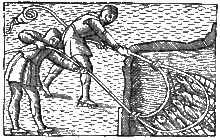Scandinavian fair

The Skåne Market ( Danish Skånemarkedet ; Swedish Skånemarknaden ; German: "Already the market") was in medieval times a year during the period of fishing for herring held Mass in Skanör-Falsterbo on the peninsula Falsterbo in the then Danish Scania . Herring, but also other finished and semi-finished products and raw materials were traded there. The fair took place between the end of July and the end of October, but in some years it was extended until mid-November.
The rich herring fishing grounds north of the Falsterbo peninsula were the reason for this largest northern European trading event of the Middle Ages, which has been taking place since the beginning of the 12th century, and contributed significantly to the rapid rise and wealth of the Hanseatic cities of the Wendish quarter of the Hanseatic League , especially Lüneburg and Lübeck , however also from Wismar , Rostock , Stralsund and Danzig . Herring was a popular and necessary lent in the Middle Ages, which was rich in fasting days , and therefore a sought-after commodity. Barrels and salt were needed to preserve the fish for transport to continental Europe . The nearest rich salt deposits were in Lüneburg; From there, the salt was first brought to Lübeck via the Alte Salzstrasse and then, together with the barrels, to Falsterbo. In addition, there were deliveries of daily necessities for the up to 20,000 people present there during the season (beer as a staple food at the time, meat, etc.). Most of the assistants working there were also brought along on ships from the German cities on the Baltic coast. In the Öresund from Falsterbo to Dragør on the island of Amager on the west bank of the sound, up to 500 ships of different sizes were temporarily moored at the same time. The smallest could load four to five barrels of herrings, the largest around 400. From 1398, salt was transported between Lüneburg and Lübeck via Europe's first canal to cross a watershed, the Stecknitz Canal . The cured herring was transported back in the barrels the same way.
The Danish crown awarded to the cities of the Hanseatic League, but much to their chagrin and to the surrounding drivers mentioned merchants from England and the Netherlands, known as Vitten , concessions to a particular piece of land in the meadows of the peninsula on which these are necessary for the fishing season Buildings erected. The size of the Vitten varied from town to town; Lübeck and Danzig had the largest, each with six to ten hectares. The Vitten were subordinate to the elders of the respective cities, who also held the jurisdiction. The merchants from the Hanseatic cities who worked there were organized in special merchants' corporations, the Schonenfahrer - guilds of their cities of origin, which, because of the economic importance of the Schonenfahrt for the cities, also had a considerable influence on the council of their city. From the point of view of the Danish crown, the concessions for the Vitten made a significant contribution to the Danish state budget, as did the Sundzoll later on .
The struggle for privileges in this business was one of the key points in the constant and often armed conflicts between the Hanseatic cities and the Danish kings. In the Peace of Stralsund (1370) the Hanseatic League was able to secure the herring market in Skåne as a monopoly for the period up to 1385 and thus free itself from the increasing competitive pressure of the surrounding area. The character of the trade fair was thus canceled in favor of the domestic stacking rights and the market was reduced to a pure herring market.
The lack of herrings around 1560 put an end to the heyday of markets in Skåne. Skanör and Falsterbo nearly devastated . This was accompanied by the economic decline of the cities in the Wendish quarter of the Hanseatic League.
literature
- Philippe Dollinger : The Hanseatic League. 2nd revised edition. Kröner, Stuttgart 1976, ISBN 3-520-37102-2 ( Kröner's pocket edition 371).
- Carsten Jahnke : The silver of the sea. Böhlau Verlag, Cologne, Weimar, Vienna, 2000, ISBN 3-412-10599-6 .
